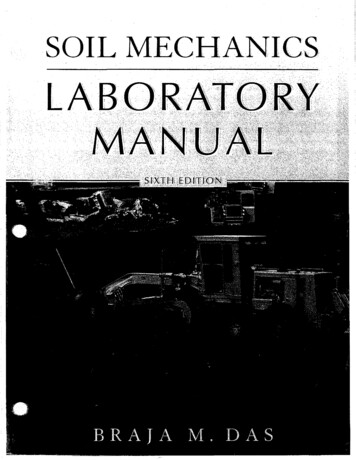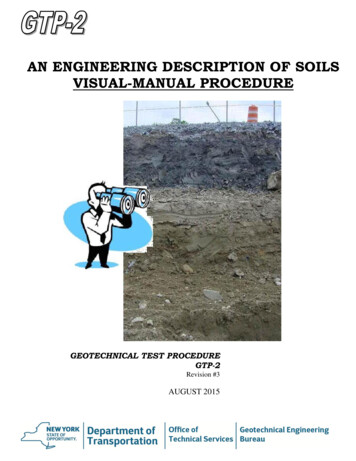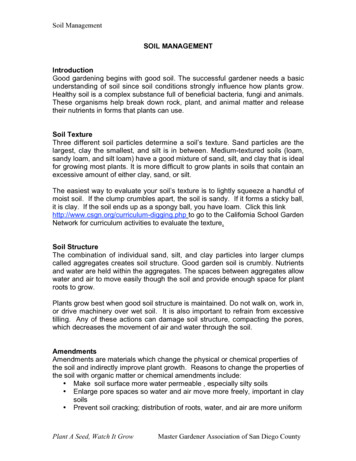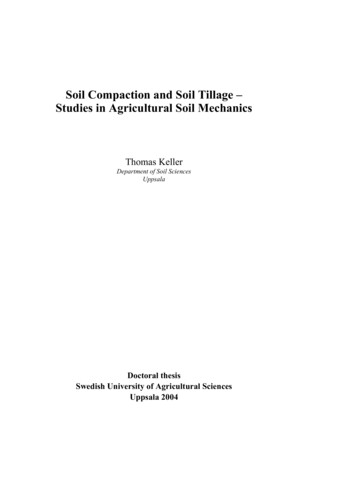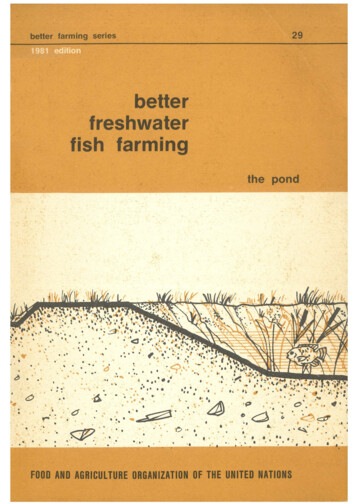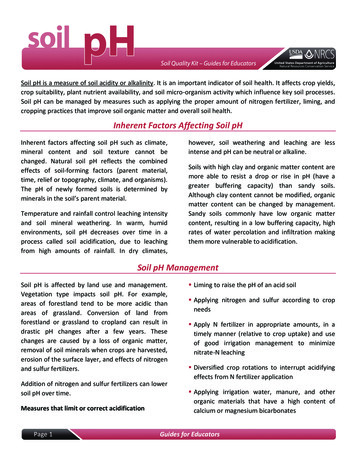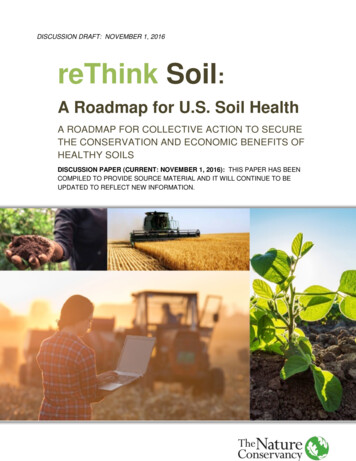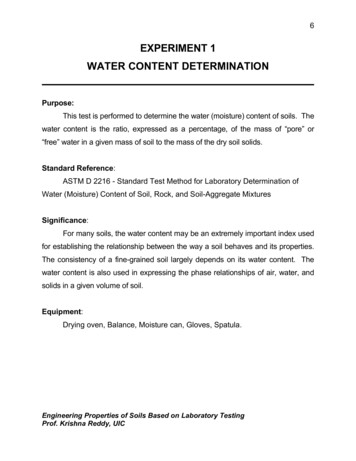
Transcription
FINAL PROGRAMPRESENTED BY THEJULY 26–29, 2015SHERATON GREENSBOROAT FOUR SEASONSGREENSBORO, NC
TABLE OF CONTENTS2Conference Schedule in Brief4Welcomes & Volunteer Recognition4Program Committee Chair5Hugh Hammond Bennett Chapter6Conference Volunteers7Conference Registration & Facility Information8Sheraton Greensboro Meeting Space Map10SWCS Board of Directors, Officers & Staff11Conference Sponsors12SWCS Corporate Members13Exhibitor Information15Poster Presentations17Daily Event SWCS Conference Sites & Presidents1
Conference Schedule in BriefMondaySunday11:00 a.m.Registration OpensRegistration Desk6:45 a.m.Registration OpensRegistration Desk12:00 p.m.House of Delegates, State of Society Address,Leadership Development Training, andRegional Roundtable MeetingsVictoria A7:15 a.m.Morning Coffee and Soil Health PartnershipFarmer PanelGuilford F/G8:30 a.m.Opening Welcome and Pritchard LectureGuilford F/G1:00 p.m.*COMET-Farm: Agriculture and ForestryCarbon and Greenhouse Gas Accounting atYour FingertipsSandpiper10:00 a.m.Morning Break: Exhibit Hall andPoster Presentations OpenImperial A/B/C/D1:30 p.m.*Nitrogen Tools WorkshopTanglewood10:30 a.m.Concurrent SessionsSee page 222:00 p.m.*Tips for Successful Grant WritingTidewater A10:30 a.m.CIG Showcase and PostersAugusta/Tidewater3:30 p.m.Fellows ForumVictoria A12:00 p.m.Lunch BreakOn your own4:30 p.m.Student Networking SessionGrandover East12:00 p.m.ARCSE Lunch and Annual Business MeetingGrandover West5:30 p.m.International Committee MeetingLinks12:30 p.m.Science and Policy Committee MeetingOak A5:30 p.m.JSWC Editorial Board MeetingEdgewood1:30 p.m.Concurrent SessionsSee page 235:30 p.m.New Members/First-Timers OrientationVictoria B1:30 p.m.CIG Showcase and PostersAugusta/Tidewater6:30 p.m.Welcome Reception3rd Floor Pre-Function Space3:00 p.m.ARCSE Board MeetingGrandover West3:00 p.m.Afternoon Break with ExhibitorsImperial A/B/C/D3:30 p.m.Concurrent SessionsSee page 243:30 p.m.CIG Showcase and PostersAugusta/Tidewater5:30 p.m.Exhibitor and Poster Reception in Exhibit HallImperial A/B/C/D7:00 p.m.Silent Auction EndsImperial A/B/C/D7:30 p.m.Hugh Hammond Bennett ChapterGame Night and Live AuctionColony A*Additional fees apply2
TuesdayWednesday7:00 a.m.Professional Development Committee MeetingOak A7:00 a.m.*CEAP Calhoun Critical Zone Observatory Tour7:30 a.m.Registration OpensRegistration Desk7:00 a.m.*North Carolina State University Lake WheelerField Laboratory and Syngenta Tour7:30 a.m.Morning Coffee - sponsored by EnvirocertInternational, Inc, and Light BreakfastGuilford Foyer8:00 a.m.*Soil Health Farm Tour8:00 a.m.Tuesday PlenaryGuilford F/G8:00 a.m.*North Carolina Viticulture Research andRaylen Vineyards and Winery Tour8:30 a.m.USDA-NIFA NIWQP and ARFI Annual ProjectDirector’s Meeting – Day 2Victoria A10:00 a.m.Morning Break in Exhibit HallImperial A/B/C/D10:30 a.m.Concurrent SessionsSee page 3310:30 a.m.2015 USDA-NIFA NIWQP and ARFIAnnual Project Director’s MeetingVictoria A12:00 p.m.*Awards LuncheonGuilford D12:00 p.m.Lunch BreakOn your own1:30 p.m.Concurrent SessionsSee page 341:30 p.m.2015 USDA-NIFA NIWQP and ARFIAnnual Project Director’s MeetingVictoria A1:30 p.m.ARS-WAS Cropland CEAP AnnualMeetingColony B3:30 p.m.Concurrent SessionsSee page 353:30 p.m.2015 USDA-NIFA NIWQP and ARFIAnnual Project Director’s MeetingVictoria A3:30 p.m.ARS-WAS Cropland CEAP AnnualMeetingColony B5:00 p.m.Focus Group for Recipients of USDANIFA Funding During 2001-2013Meadowbrook5:15 p.m.SWCS Annual Conference ProgramCommitteeOak A6:00 p.m.Hugh Hammond Bennett ChapterMemory Lane EventColony A* Additional fees apply*Additional fees apply3
Program Committee Chair MessageThis is the third time I have had the pleasure of serving as program planning chair of the SWCS Annual Conference. Each timeI am humbled by the generosity of talent and time from those who submit presentations and programming, and those whoserve to review submissions and support authors in becoming accepted. Thank you to all who have served in these capacities.The content of this conference is excellent because of you.The 70th anniversary program includes many topics of continued importance to conservation professionals; it also includesan overarching theme of “Putting Science into Practice.” The program planning committee hopes that this theme will remindus all of the value of discovery and its role in implementing evidence-based conservation on the landscape. The professionaldiversity of SWCS membership and guests at this conference create the perfect atmosphere in which to share ideas and makeconnections between science and practice.For the 2016 conference, program planning will be led by Deanna Osmond (chair) and supported by DeAnn Presley (cochair). SWCS and this conference will benefit greatly from their expertise and enthusiasm.Finally, I would be remiss if I didn’t mention that all of us are participating in the 70th Anniversary Conference in the homestate of Hugh Hammond Bennett. Welcome to North Carolina and welcome home to conservation!Tommy Bass, Program Planning ChairMontana State University44
Hugh Hammond Bennett Chapter WelcomeWelcome to the Home of ConservationTo every friend of soils, water quality, and conservation work, from lands far and near, this is our year to celebrate! We are soexcited to have you join us IN the state where soil conservation began, DURING the International Year of Soils, and WITHthe most welcoming folks around.We want all soil conservationists to feel right at home here in North Carolina. After all, this is the birthplace of the Father ofSoil Conservation, Hugh Hammond Bennett. If you have any questions about North Carolina, the SWCS Hugh HammondBennet Chapter (HHB), or the location and home site of Hugh Hammond Bennett, just ask a local chapter member (look forvolunteers wearing tan vests). We simply LOVE to talk about our legacy and our state.North Carolina is a fabulous state, and we hope you will return on many occasions. There are many facts that you may ormay not know about North Carolina.You may already know that Mount Mitchell is the highest peak in the eastern United States or that North Carolina ranks numberone in production of tobacco and sweet potatoes. Looking at a map, you may guess that there are more than 300 miles ofshoreline on North Carolina’s coast, more than any other state on the East Coast. We are number one in solar power for thesouthern states, and number four nationwide. The coastal city of Wilmington is known as Hollywood East, and many moviesand TV shows were filmed in North Carolina, including Iron Man 3, The Last of the Mohicans, Dirty Dancing, and Homeland.There are 10 million people who call North Carolina home. These rural and urban citizens help support our stronglybalanced economy of agriculture and business. North Carolina State University and North Carolina A&T provide an excellentfoundation for our conservation, forestry, and agricultural studies. Duke University is a leader in graduate school researchcovering environmental management and natural resources.Western North Carolina includes Great Smoky Mountains National Park and the Blue Ridge Parkway, two of the most-visitedattractions in the National Park System. If you go east, visit Cape Hatteras, which was America’s first national seashore. Don’tforget to see the wild horses on Shackleford Banks near Morehead City and Atlantic Beach. North Carolina is also home tofour national forests and more than 40 state parks where you can camp, kayak, hike, fish, picnic, and more.You may not, however, know that more species of salamanders live in the North Carolina mountains than any other place inthe world. In addition, the Great Smoky Mountains boast more than 1,400 varieties of flowering plants and 100 species oftrees (more species of trees than in the whole of Europe). By the way, North Carolina is the birthplace of Forest Conservationin America. In 1898, Carl Schenck started the first school of forestry, the Biltmore Forest School near Asheville. The Venus FlyTrap is only found in a 50-mile radius from Wilmington. The Uwarrhie Mountains are the oldest mountain range in NorthAmerica, and Transylvania County has more waterfalls than any county east of the Mississippi. Also—a bit more important tosome of us—North Carolina has 448 soils series, and Cecil is our official state soil.I hope you enjoy your time here in North Carolina. Members of the Hugh Hammond Bennett Chapter are here to welcomeand assist you with a successful, fun, and educational conference visit. I invite you to find me at this historic 70th AnnualSWCS International Conference and say hello. I want to meet everyone from soils near and far.Dale Threatt-Taylor, PresidentHugh Hammond Bennett Chapter55
2015 SWCS Conference VolunteersThank you to all who assisted in planning the70th SWCS International Annual Conference!LEADERSHIP AND LIAISONSTommy Bass, Montana State UniversityChairTECHNICAL TEAM LEADERSCraig Allen, University of Nebraska-LincolnAdaptive Management of Conservation EffortsJorge Delgado, USDA-ARSJSWC Editorial Board LiaisonPhilip Buchanan, USDA-NRCSConservation Economics and PolicyRebecca Fletcher, USDA-NRCSLeadership Development LiaisonDeborah Cavanagh-Grant, University of Illinois-ExtensionConservation in Nontraditional AgricultureJohn Kluthe, USDA-NRCSProfessional Development LiaisonKatie Flahive, EPAWater Resource Assessment and ManagementDeanna Osmond, North Carolina State UniversityCo-ChairJanet Perry, USDA-NRCSChrissy Rhodes, SWCSSWCS Exhibits and SponsorsDeAnn Presley, Kansas State UniversitySoil Health Resources, Indicators, Assessment, andManagementAndrew Sharpley, University of ArkansasScience and Policy LiaisonLinda Prokopy, Purdue UniversitySocial Sciences Informing ConservationCheryl Simmons, USDA-NRCSInternational Activities LiaisonMark Risse, University of Georgia-AthensOutreach, Education, and Community EngagementKim Johnson-Smith, SWCSSWCS Operations and ProgramsCheryl Simmons, USDA-NRCSConservation Models, Tools, and TechnologiesJeffrey Strock, University of MinnesotaSSSA S06 LiaisonMark Weltz, USDA-ARSUSDA-ARS Grazinglands CEAP LiaisonHUGH HAMMOND BENNETT CHAPTER LIAISONSDale Threatt-TaylorSWCS HHB Chapter PresidentJim CanterberryHHB Historical CollectorPat HarrisGames Night CoordinatorTeresa HiceSilent Auction CoordinatorGail HughesTour CoordinatorShawn SpringerVolunteer Coordinator6
Conference Registration & Facility InformationThe Soil and Water Conservation Society registration deskis located on the 1st floor, outside the Imperial Ballroom.SWCS staff members will be on site to assist you.REGISTRATION HOURSSunday 11:00 a.m. – 6:30 p.m.Monday 6:45 a.m. – 5:30 p.m.Tuesday 7:30 a.m. – 5:00 p.m.quality (CPSWQ), and other professional conservationistsmay be able to obtain CEUs.Please pick up a CEU tracking/sign in sheet at the registrationdesk and have each room moderator sign the sheet asappropriate. Return the form to registration at the end of theconference, and we will submit it on your behalf.TICKETS AND PASSESThe conference registration fee covers one participant. Allregistered attendees will receive a registration packet, whichcontains a formal name badge and tickets for purchased events.Your name badge acts as your admission ticket toeducational sessions (including the plenary sessions),exhibits, posters, and special events. Please be sure yourname badge is worn at all times in the conference area. Foryour safety, it is recommended that you do not wear yourname badge outside the conference area. Please note thattickets will be collected for all ticketed events.Formal name badges are not provided for guests. Additionaltickets for guests to attend the Welcome Reception onSunday evening, the Exhibit and Poster Reception onMonday evening, educational tours, or the Awards Luncheonmay be purchased at the Registration Desk and are subjectto availability.Please Note: No refunds will be given for conferenceregistrations, workshops, tours, meal functions, or activities.Registration personnel will not exchange tickets. SWCS reservesthe right to cancel events/activities without prior notice.LOST AND FOUNDCheck with the hotel registration desk or at the SWCSregistration desk.MEDICAL SERVICESFor medical emergencies, dial “0” from any house phone orroom phone.CEUSSWCS has worked to secure continuing education credits(CEUs) from various certifying organizations. Certified,licensed, or professional engineers (PE), agronomists (CPAg),soil scientists and classifiers (CPSS and CPSC), crop advisors(CCA), crop consultants (CPCC), foresters, range managers(CPRM), grassland professionals (CGP), professionals inerosion and sediment control (CPESC) and storm water7
Sheraton Greensboro at Four SeasonsMeeting Space MapSouthLobbyEntryfiRst flooRguilfoRDBallRoomE IIAuditorium IIPrefunction AreaCafeExpressoWCCCDD4D3D5Auditorium IIID6EWCFCardinalCGuilford dGateCityWCBBiltmoreAginadLockDoRoom Dimensions anD seating CapaCityClassroomBanquetovals of quarefeetCeilingHeight25’ x 17’425seConDflooR36’meetingx 28’1,00828’ xRooms18’50428’ x 18’28’ x 25’28’ x 25’26’ x 24’25’ x 22’23’ x 19’200’ x 200’90’ x 50’100’ x 90’90’ x 50’90’ x 50’90’ x 50’90’ x 50’90’ x 50’200’ x 20’11’11’11’11’11’11’11’11’Oak ficessheraton greensboro Hotel at fourStatueseasonsBirchFitness CentergReensBoRo, noRtH CaRolinaStagePrefunction AreaEscalatorGate CityfiRst flooR Permanent Conference for 14Biltmore10055impeRialBiltmore A4525BallRoomBiltmore B4525Morehead6030Blandwood6030CarolinaAuditorium I4027Old NorthPermanent Conference for 16CardinalPermanent Conference for 10Auditorium IIPermanentConcierge Classroom Seating for 154D2Auditorium IIIPermanentClassroom Seating for 154DeskDIWC Square FeetPrefunction Area30,000Guilford Ballroom6,000WC 2,800Guilford(R) 600 (T) 555280EI AStatueGuilford B1,100520WC WCGuilford C555280Guilford D550280Guilford E580280Guilford F580280A 550 BCGuilford G280CorridorlengthX WidthWCReceptionor theatreWCRoomname3121 High point Roadt — 336 292 9161sheratongreensboro.comHRoom Dimensions anD seating CapaCityRoomReceptionlengthsquareCeiling
Sheraton Greensboro at Four SeasonsMeeting Space MaptHiRD flooRmeetingRoomspRefunCtionviCtoRia WingThird FloorSawgrasssheraton greensboro Hotel at four seasonsgReensBoRo, noRtH CaRolina3121 High point Roadt — 336 292 9161sheratongreensboro.com9
SWCS Board of Directors, Officers & StaffOFFICERSPresident: Mark BerklandVice President: Cheryl SimmonsSecretary: John RisslerTreasurer: Tom ProutAT-LARGEJohn Rissler2013 – 2016Dan Towery2009 – 20122012 – 2015Jon Scholl2014 – 2017Bruce Knight2014 – 2017Rex Martin (incoming) 2015 – 2018NORTHEAST REGIONWendi Goldsmith2014 – 2017SWCS HEADQUARTERS STAFFJim Gulliford, Executive DirectorAnnie Binder, Director of Publications/Journal EditorCammie Callen, Member Services SpecialistKim Johnson-Smith, Professional Development DirectorJody Ogg, ComptrollerChrissy Rhodes, Program CoordinatorJody Thompson, Editorial AssistantNORTH CENTRAL REGIONTom Prout2012 – 2015Susan Meadows2013 – 2016NORTHWEST REGIONDon Wysocki2014 – 2017SOUTHEAST REGIONMark Berkland2010 – 20132013 – 2016POLICY REPRESENTATIVEJohn Peterson, Washington, DCSOUTHWEST REGIONCheryl Simmons2012 – 2015Michael Collins2013 – 2016N O R T HC A R O L I N AWATER QUALIT Y WATER QUANTIT Y EDUCATIONEROSION AND SEDIMENT CONTROL STORMWATER GROUNDWATERTECHNOLOGY TRANSFER AGRICULTURE LOW IMPACT DEVELOPMENTWATER LAW & POLICY WATERSHED MANAGEMENT WATER UTILIT Y ASSISTANCEHeadquartered at North Carolina State University, the Water Resources Research Institute of the University of North Carolina Systemis one of 54 state water institutes that were authorized by the Water Resources Research Act of 1964.We a s s i s t federal, state and local agencies in their missions by facilitating research and technology transfer.We p r o v i d e research results to industry and practitioners for effective water management and regulatory compliance.We i n f o r m water resource professionals through workshops and publications about our state’s water resources.We f u n d research and outreach that address important water issues with a statewide network of 17 campuses and private universities.We s u p p o r t local watershed management by coordinating the NC Watershed Stewardship Network and local watershed restoration efforts.w w w.nc su.edu/wrri10
Conference SponsorsPresenting SponsorElite EnvironmentalistSoil SustainerWater Warrior11
SWCS Corporate MembersSWCS is pleased to have the following organizations as corporate members and partners in the effort to advance naturalresource conservation and environmental sustainability.Gold MembersSilver MembersBronze MembersAre you interested in having yourorganization recognized for itsdedication to natural resourcesprotection and sustainability?Contact Chrissy Rhodes at515-289-2331 x 114 or emailcorporate.info@swcs.org to discussall of the benefits of becoming anSWCS corporate member.12
Conference ExhibitorsBooth #ExhibitorContacts/Representative1US Environmental Protection Agency – water.epa.govKatie Flahive2Watershed Materials, LLC – www.maddogfoambridges.comCarl Hamman & Garrett Rhyne3Agren – www.agrentools.comTom BumanSoil Health Partnership – www.soilhealthpartnership.orgNick Goeser6American Farmland Trust – www.farmland.orgMike Baise & Jen Filipiak7Syngenta – www.syngenta.comAnn Bryan & Jill Wheeler8La Crosse Seed – www.laxseed.comChris McCracken9EnviroCert International, Inc. – www.envirocertintl.orgRob Vanscoy & Sandy Gibbs10USDA-NRCS: Celebrating the International Year of Soils– www.nrcs.usda.govAmy Overstreet & David Smith11USDA-NRCS – www.nrcs.usda.govRon Nichols & Peg Reese12National Association of Conservation Districts (NACD)– www.nacdnet.orgBill Berry & Rich Duesterhaus13AMS Inc. – www.ams-samplers.comHari Anestos14Southern SARE – www.southernsare.orgCandace Pollock15USDA-NASS – www.nass.usda.govDee Webb16Voss Signs – www.vosssigns.comTom Tenerovicz17XYLEM / YSI – www.ysi.comScott Kindelberger18Truax Company, Inc. – www.truaxcomp.comMichael Hall19USDA-NRCS-CNTSC – www.nrcs.usda.govCheryl Simmons20USGS South Atlantic Water Science Center– www.usgs.gov/water/southatlanticChad Wagner21Great Plains Mfg., Inc. – www.greatplainsag.comJohn Parker22Ward Labs Inc. – www.wardlab.comLance Gunderson23Crop Health Labs – www.crophealthlabs.comMichelle Gregg24Agri Drain Corporation – www.agridrain.comJeff Harris & Charlie Shafer25Verdesian Life Sciences – www.vlsci.comDave Schwartz & Larry Shivers26Dow AgroSciences – www.dowagro.comTony Weiss27National Center for Appropriate Technology (NCAT)– www.ncat.org/www.attra.orgChris Lent28COMET-Farm – www.comet-farm.comMark Easter & Matthew Stermer29Ernst Conservation Seeds – www.ernstseed.comGreg Kedzierski30Eijkelkamp – www.eijkelkamp.comTroy Chipps & Rob Stolsz4&513
Exhibit Hall LayoutSheraton Greensboro at Four Seasons,Imperial Ballroom A,B,C, and D14
Poster PresentationsADAPTIVE MANAGEMENT OF CONSERVATION EFFORTS1. Adaptive Management of Young Longleaf Pine Stands inSoutheastern Virginia2. Adaptive Nitrogen Management for Corn, Sorghum, andWheat in the Coastal Plain of North Carolina3. Arkansas Discovery Farms: Increasing Water Sustainabilitywith Irrigation4. Bridging the Gap between University Science andLocal Policy to Achieve Nutrient Loss Reduction: The RoleUniversity Centers Can Play5. Future Directions of Usable Science for RangelandSustainability6. Grass and Agroforestry Buffer Influence on SpatialDifferences of Selected Soil Quality Parameters7. Improving Irrigation Efficiency in Soybeans with PipePlanner Design and a Surge Valve8. Phosphorus Recovery Prior to Land Application of BiosolidsUsing the “Quick Wash” Process Developed by USDA9. Several Years Application of Some Amendments on SoilPhysical Properties of a Light-Textured Soil10. Yields of No-till Irrigated Continuous Corn Can BeIncreased with Controlled-Release FertilizerCONSERVATION ECONOMICS AND POLICY11. Market-Based Solutions in ConservationCONSERVATION MODELS, TOOLS, ANDTECHNOLOGIES12. Assessing Agroforestry Greenhouse Gas Emissions andSequestration with COMET-Farm13. Assessing Cropland Greenhouse Gas Emissions UsingCOMET-Farm14. Assessing Livestock Greenhouse Gas Emissions withCOMET-Farm15. Considerations and Resources on Feed and AnimalManagement to Reduce Greenhouse Gas Emissions andImprove Business Value for Dairy Farms in the United States16. Dryland Cropping Systems for the Central High Plains ofNorth America18. The Application and Use of Unmanned Aerial Systems inPrecision AgricultureOUTREACH, EDUCATION, AND COMMUNITYENGAGEMENT19. Facilitating Community-Based Conservation Initiatives inChesapeake Bay, Morgantown, and Berks County, Pennsylvania20. Private and Public Sector Conservation CollaborationEngages Plain Sect Farmers to Improve Soil and StreamHealth in the Lancaster County, Pennsylvania, Drainage Areato the Chesapeake Bay21. Small Scale Agriculture—FAS and NRCS International Program22. Soil and Water Science Curriculum for InformalYouth Education23. Texas Watershed Steward ProgramSOCIAL SCIENCES INFORMING CONSERVATION24. Improving Food Security through Soil Conservation forSmallholder Farmers in Rural El Salvador25. Useful to Usable (U2U): Transforming ClimateInformation into Usable Tools to Support MidwesternAgricultural ProductionSOIL RESOURCE ASSESSMENT AND MANAGEMENT26. Assessing and Demonstrating Soil Restoration Practiceson Disturbed Land in New Jersey’s Coastal Plain27. COMET-Farm, a Modeling and Measuring Tool forGreenhouse Gases (GHG) that Can Target Soil Health28. Efforts to Improve Soil Restoration Requirements onDisturbed Land in New Jersey29. Incorporating Multiple Ecosystem Services into theDesign of Low Impact Development Strategies30. Influence of Agroforestry Buffers and Row CropManagement on Soil Hydraulic Properties31. Long-Term Soil and Crop Management Effects on SoilPhysical Properties Related to Soil Erodibility32. Nitrogen Rate and N Loss-Prevention Additive Effects onCorn and Wheat Yields in North Carolina33. Water Infiltration in Claypan Soils Influenced by Agroforestryand Grass Buffers for Row Crop Management Systems17. Geospatial Products for Conservation and Monitoring ofTree Resources in Agroecosystems15
WATER RESOURCE ASSESSMENT AND MANAGEMENT34. Arkansas Discovery Farms: Monitoring Nutrient Loss inRunoff From Soybean Fields35. Collaborative Opportunities for Watershed Protectionand Flood Prevention through USDA’s Regional ConservationPartnership Program36. Monitoring Nutrient Runoff from Cotton on the ArkansasCotton Discovery Farm37. Optimal Allocation of Agricultural Water Use in theHumid Southeastern US Using Hydro-Economic ModelingSARE: Since 1988.pioneering change innovation byinnovation.making a difference result by result.38. Prediction of Drawdown around a Radical Collector Well39. The Effects of Land Use Changes and Climate Variabilityon Reservoir Sedimentation for the Little Washita RiverExperimentation Watershed.improving lives farmer by farmer.40. Treatment of BPA Contaminated Stormwater withManganese Oxide-Coated Sand41. Water Vulnerability to Diffuse Pollution from Agriculture:A Case Study in Lincolnshire County, UK42. Watershed Planning in TexasPRECISION CONSERVATION43. Nutrient Dynamics in Root Zone of Soil WaterRetention Technology44. Subsurface Application of Poultry Litter to Improve Airand Water QualityWATER SCIENCE IN THE PUBLIC INTEREST45. Balancing River Flow and Associated Ecological andCultural Needs at the Chattahoochee River NationalRecreation Area46. Climate Variability and Change with Elevation in Kenya,East Africa47. Water for the Seasons: Evaluating the Feasibility ofDomestic and International ImplementationGrants and Education to AdvanceSustainable Agriculturehttp://www.southernsare.orgDig DeeperDiscover the CO2 Factor in Your Soil.Make smarter fertility decisions.Soil Biology KitCall: 800-451-0337 solvita.com/FieldTest16
Sunday, July 26 Schedule & EventsSchedule11:00 a.m.Registration OpensRegistration Desk12:00 p.m.State of Society Address, House of Delegates,Leadership Development Training, andRegional Roundtable MeetingsVictoria A1:00 p.m.*COMET-Farm: Agriculture and ForestryCarbon and Greenhouse Gas Accounting atYour FingertipsSandpiper1:30 p.m.*Nitrogen Tools WorkshopTanglewood2:00 p.m.*Tips for Successful Grant WritingTidewater A3:30 p.m.Fellows ForumVictoria A4:30 p.m.Student Networking SessionGrandover East5:30 p.m.International Committee MeetingLinks5:30 p.m.JSWC Editorial Board MeetingEdgewood5:30 p.m.New Members/First Timers OrientationVictoria B6:30 p.m.Welcome Reception3rd Floor Pre-Function Space*Additional fees applyEventsSTATE OF THE SOCIETY, HOUSE OF DELEGATES,LEADERSHIP DEVELOPMENT TRAINING, ANDREGIONAL ROUNDTABLE MEETINGS12:00 p.m. – 3:00 p.m., Victoria AThe annual SWCS meeting will include President MarkBerkland’s State of the Society address, the Annual Reportfrom Executive Director Jim Gulliford, and the House ofDelegates session. Immediately following the House ofDelegates, the Leadership Development Committee wouldlike to invite all guests to participate in an interactiveleadership training:Leadership Development Training: Discover the BrandingPower of ONE – Ron Nichols, USDA-NRCSLearn how personal branding power can be put to use athome, on the job, in the community, and more importantlyfor SWCS chapters! In this fun, interactive workshop you’lldiscover the amazing power of a single voice; how to assesspersonal brand attributes; how to define and live personalbrand legacy; and how to become a “brand warrior” (forany cause). Participants will learn why every person in theorganization is a reflection of their brand and how to ensureeach team member’s projects deliver the organization’sbrand value. Recruiting new members to the Society andpotential board members to the local chapter are just two ofthe many tools participants will gain from this training.Following the leadership training, chapters will have theopportunity to discuss information within small groups.WORKSHOP: COMET-FARM: AGRICULTURAL ANDFORESTRY CARBON AND GREENHOUSE GASACCOUNTING AT YOUR FINGERTIPS1:00 p.m. – 5:00 p.m., SandpiperInstructors: Matthew Stermer, Colorado State University;Mark Easter, Colorado State University; Kevin Brown,Colorado State UniversityCOMET-Farm is the practical, web-based application of theUSDA entity-level methods for greenhouse gas inventories.Workshop attendees will receive hands-on instructionon greenhouse gas accounting at the field, parcel, farm,and ranch scale. Attendees will learn how to use andapply the COMET-Farm tool to calculate the entity-levelgreenhouse balance of farm, ranch, agroforestry, andforestry operations, and will complete conservation scenarioanalyses. The workshop will focus on how the COMET-Farmtool was developed, practical examples of crop, livestock,agroforestry, and forestry scenarios, and how to interpret andreport greenhouse gas inventories.WORKSHOP: NITROGEN TOOLS1:30 p.m. – 5:00 p.m., TanglewoodInstructor: Jorge A. Delgado, USDA-ARSThe Nitrogen Tools workshop will provide training on theNitrogen Index for Windows XP and Windows 7. Attendeesof the workshop will receive handouts to follow along withthe presenter’s examples. Workshop participants will gainhands-on experience using these tools (the Nitrogen Index,Phosphorus Index, and N2O Index), which can be used byTechnical Service Providers (TSP), conservationists, nutrientmanagers, and others. The ultimate goal is to improvenitrogen use efficiency at the farm level to maintain yields,17
Sunday, July 26 Schedule & Eventscontinuedincrease economic returns for farmers, and minimizenitrogen losses to the environment.STUDENT NETWORKING SESSION4:30 p.m. – 6:30 p.m., Grandover EastWORKSHOP: TIPS FOR SUCCESSFUL GRANT WRITING2:00 p.m. – 4:30 p.m., Tidewater ASWCS student colleagues are invited to join the SWCSProfessional Development Committee, along with a varietyof conservation industry professionals and guests fromvarious conservation disciplines, for an interactive discussionabout planning for a career in environmental conservation.Students will gain advice on how to match education tothe needs of the industry and learn successful practicesfor employment after graduation. Attendees will alsoengage in professional networking and more. Attendance isencouraged for student members and professionals wishingto connect with students.Instructors: Denis Ebodaghe, USDA-NIFA; James Hill, SustainableAgriculture Research and Education Program (SARE)Advance planning and preparation are the keys to successfulgrant writing. In this interactive workshop, presenters willdemonstrate how goals and objectives, when well-articulated,can result in successful receiving funding for a project. Thisworkshop will touch on tools needed to submit a grant thataccurately addresses key areas such as evaluation criteria,qualifications and experience to carry out project work,funding to conduct project work, evaluation of project work,project sustainability beyond the expiration of the grant, andelectronic submission. By the conclusion of this workshop,attendees will have the opportunity to prepare and critiqueexamples of short grant proposal submissions.FELLOWS FORUM3:30 p.m. – 5:30 p.m., Victoria AYou are in Jordan Lake Watershed: Regulation, Agriculture,Water Quality, and TradingPresenters: Rich Gannon, North Carolina Department ofEnvironment and Natural Resources; Deanna Osmond, DanLine, and Caela O’Connell, North Carolina State University;Mazkak Arabi and Dana Hoag, Colorado State UniversityJordan Lake provides drinkin
3:30 p.m. 2015 USDA-NIFA NIWQP and ARFI Annual Project Director's Meeting Victoria A 3:30 p.m. ARS-WAS Cropland CEAP Annual Meeting Colony B 5:00 p.m. Focus Group for Recipients of USDA-NIFA Funding During 2001-2013 Meadowbrook 5:15 p.m. SWCS Annual Conference Program Committee Oak A 6:00 p.m. Hugh Hammond Bennett Chapter Memory Lane Event .


